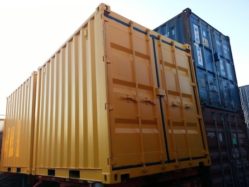When many people think of storage, they imagine self-storage facilities, warehouses, or maybe renting extra space in a commercial building. But there’s a compelling alternative that’s gaining popularity: using 40-foot shipping containers (also called “ISO containers” or “freight containers”) as on-site or off-site storage. Here’s why that can be especially beneficial in a place like Columbus, Ohio.
1. Massive Storage Capacity & Cost Efficiency
- A 40-foot container offers significantly more volume than smaller containers (e.g. 20 ft). This means when you need to store a lot of stuff—equipment, inventory, supplies, seasonal items—one 40′ container often replaces multiple smaller units.
- Because of “economies of scale,” the cost per cubic foot of storage goes down. You’re making better use of the container’s structure and logistics, rather than paying separately for many smaller units.
- Compared to building a dedicated storage building or renting extra warehouse space, containers often require a lower upfront investment and lower maintenance.
2. Durability, Security & Weather Protection
- These containers are built to withstand harsh conditions (they’re meant for marine, rail, and truck transport), so they’re rugged, weather-resistant, and secure.
- When properly sealed, containers are watertight—so your belongings are protected from rain, snow, and moisture intrusion.
- The robust steel construction and locking mechanisms help deter theft, vandalism, and unauthorized access.
In Columbus, Ohio, where you’ll see significant precipitation, humid summers, freezing winters, and occasional storms, that kind of protection matters. A container will shield stored items from the elements in a way that many outdoor tarps, open sheds, or makeshift structures cannot.
3. On-site Storage & Easy Access
- Because containers are portable, you can bring the storage “unit” to your site—your property, business yard, construction site—rather than having to haul everything to a remote storage facility. That saves time, labor, and transportation cost.
- With on-site access, you can come and go as needed (depending on permit/land use) without paying recurring facility access fees or depending on facility hours.
- You can customize the container: add shelving, partitions, roll-up doors, insulation or climate control, depending on your stored items and needs.
4. Longevity & Low Maintenance
- Shipping containers are built for decades of use. With minimal maintenance (rust treatments, seal checks), they can serve reliably over many years.
- Because they’re standardized and modular, replacements or additions are relatively simple. You can scale by adding more containers when needed.
- Unlike a building, there aren't continuous costs of roofing, HVAC (unless you add it), or structural repairs (beyond corrosion control).
5. Flexibility & Adaptability
- A 40-foot container can be repurposed later: as a workshop, modular office, secure tool room, mobile jobsite storage, or even converted into custom uses (e.g. pop-up shop, studio) down the road.
- If your business or property needs change, you can relocate containers (if empty or partially empty) to new sites.
- Given the modular nature, you can expand by placing containers side by side or stacking (if site and structure allow).
6. Protection Against Local Ohio Climate Extremes
Columbus experiences hot, humid summers and cold, wet winters. Using a container helps mitigate:
- Heat & Sun Exposure: The steel walls and enclosed structure reduce direct sun damage to items. If you insulate or ventilate well, you can mitigate internal heat buildup.
- Snow, Ice & Rain: Keeps precipitation out and drains properly (if sited level).
- Humidity & Moisture: Especially critical for sensitive items (wood, electronics, paper). You can add vapor barriers, dehumidifiers, moisture-absorbing materials, or even climate control to regulate humidity inside.
- Wind & Storms: The weight and strong construction help the container resist displacement (though the foundation and anchoring matter).
7. Local Storage Alternatives & How Containers Stack Up in Columbus
- In Columbus, standard self-storage or climate-controlled units are available. E.g., StoreSpace offers climate-controlled units.
- Some companies like GoMini in Columbus offer container-based storage with off-site secure facilities.
- But compared to paying recurring facility fees, having your own 40-ft container can be more cost-effective in the long run, especially for ongoing or heavy usage.
8. Considerations & Best Practices for Columbus Deployment
To get the full benefit, here are things to watch out for and tips:
- Site prep & foundation: Ensure level, stable ground with good drainage so water doesn’t pool under or around the container.
- Ventilation / condensation control: Even watertight containers can accumulate internal moisture. Add vents, desiccants, or insulation as needed.
- Access & layout: Make sure doors open without obstruction and you have room to move large items.
- Permits / zoning: Check local Columbus or municipal codes — some areas may regulate placement, setbacks, or aesthetic requirements.
- Security features: Add lock boxes, alarm systems, lighting, cameras, or reinforced doors.
- Insulation / climate control: For sensitive items, consider insulating walls/roof or adding passive or active climate control.
- Maintenance: Periodically inspect for rust, seal integrity, and floor condition.
- Stacking / modular expansion: If you plan to stack or group multiple containers, use proper locking and structural support.
Conclusion
For Columbus, Ohio—where seasonal climate shifts, precipitation, and temperature extremes are the norm—using a 40-foot shipping container as a storage solution offers a compelling combination: high capacity, security, weather protection, long-term durability, and flexibility. Whether for personal, business, construction, or agricultural needs, a well-implemented 40′ container can outperform many conventional storage options, especially over the long run.
If you like, I can also write a version with real cost comparisons for Columbus, or talk about container suppliers/permits locally. Would you like me to expand on that?

